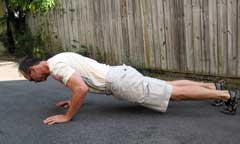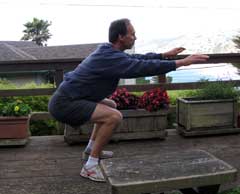Feature Article
On The Minute

When strength training, there's usually a focus on sets and reps, where "reps" are the number of repetitions performed consecutively,
and "sets" are the number of times you perform the consecutive reps, with some amount of rest in between each set. It's a time-tested
and effective way to get stronger. But sometimes, it's nice to change things up.
First, a little bit of terminology. The most common strength training programs use what are known as "straight sets" (also known as
"sets across") which means each set is performed with the same weight, and usually the same number of reps. To keep things simple,
lets leave weights out of the picture and just use bodyweight exercises. An example of straight sets of pushups is performing three sets
of ten reps, which can be written as
3x10. (There's actually no universally accepted order for writing these, and some people would
write the same thing as
10x3 but I don't and that's all that counts, right?)

Let's say that the most consecutive pushups you can do with perfect form is 10. In that case, 3x10 will be a strenuous workout and to even be
able to get 10 reps in the second and third sets will require a fair bit of rest, probably several minutes. And you'd still be straining to the
very end.
We could reduce the reps per set and instead do 3x8. That would require less rest between sets and still provide a strenuous workout, but you're
now doing 6 fewer reps than in the 3x10s. (Math is our friend!) Of course, there's nothing magical about 3 sets or 8 reps vs. 10 reps. (There is,
however, significance in the number of reps per set, the number of sets, the rest between sets, the total number of reps, and the load used in
each set, but that's
way beyond the scope of this discussion.)

But what if you wanted to get in more reps, not only to help you get stronger but also to improve your muscular endurance and your technique?
For example, what if you wanted to get in 40 pushups? Well, using our 10-rep max example, you could do 4x10 or 5x8, but either would be extremely difficult and require
long rests between sets. There is, as you might have guessed an alternative.
Welcome to
On The Minute (OTM) training! This is one of those things that I came up with on my own but lots of people beat me to it.
Nonetheless, it's a nice change of pace for getting an excellent workout. The concept is simple: Every minute, do one set of one or more
exercises. That's it! I do 20-minute OTMs because any shorter isn't a good enough workout and any longer gets boring. And I'll usually do three
exercises per minute. The key, of course, is to keep the number of reps low. Very low. Otherwise you won't have sufficient time to rest.
You also have to keep the number of reps low relative to your maximum. While there's no universal formula for determining the rep count, for
starters I recommend going with just 20% of your maximum and rounding up or down as you think best. Then try it and see how it goes, adjusting
the reps accordingly the next time you do it. I know it doesn't seem like much, but remember you'll be doing 20 sets so
don't get cocky.
Using our example of a 10-rep max on pushups, that would mean sets of just 2 reps and a total of 40 pushups. Easy, right? Why yes, yes it is.
But if you add pullups and air squats to the minutes, you're heading for a feel-that-tomorrow kind of workout. Let's say you go with 1 pullup,
2 pushups, and 4 squats per minute. (That suggests maxes of 5 pullups, 10 pushups, and 20 air squats.) Getting all those in (with pristine
form, of course) might take around 30 seconds leaving 30 seconds of rest before the next round. That makes it pretty easy on the conditioning
side, but still a good strength workout. If you were able to get your reps up to, say, 4, 6, and 8, your rest time will start to get
perilously short and by minute 20 you're likely to be doing some heavy breathing.

There are plenty of ways to vary the workout, of course. You could do only two exercises, or even four (with low reps and an easy setup). You
could go for 15 minutes or 25 or 30. You can switch to harder variations of exercises (e.g., feet-elevated pushups) or add loads (e.g.,
band-resisted pushups or goblet squats with a dumbbell or kettlebell). All these things seek to strike the not-so-delicate balance between
work and rest, ensuring that you don't completely wipe out before the last set but still finish feeling thoroughly worked out. But be warned:
sometimes, you won't feel so worked out when you complete the OTMs but will feel it a day or two later. So better to start on the easy side
and work your way up.
If you hit a minute where you can't do the full number of reps, cut the reps in half (rounding down) for the remaining sets. For example, if
you get to minute 16 and can only do 8 of 10 pushups, make it 5 reps for minutes 17-20. Even that will be tough; you'll be much better off if you
can anticipate when you won't be able to do the next complete set and preemptively reduce the reps.
In any case, track your total reps for each exercise. If you can do all the reps, try adding one rep per set next time, although that will be
a big increase since we're starting at low reps. So don't be surprised when going from, say, 2 reps to 3 reps results in going from completing
all reps to hitting the wall in minute 12 or 13.
In addition to all sorts of resistance exercises, you can also try things like running up and down a flight of stairs or flipping a tractor
tire.
One other nice thing about OTMs is they usually require little or no warm-up since you're doing a small percentage of your max. By the time
the sets get challenging, you're warmed up from the earlier sets.
So make the most of every training minute ... get out there and try some OTMs!
Be seeing you.
-gary